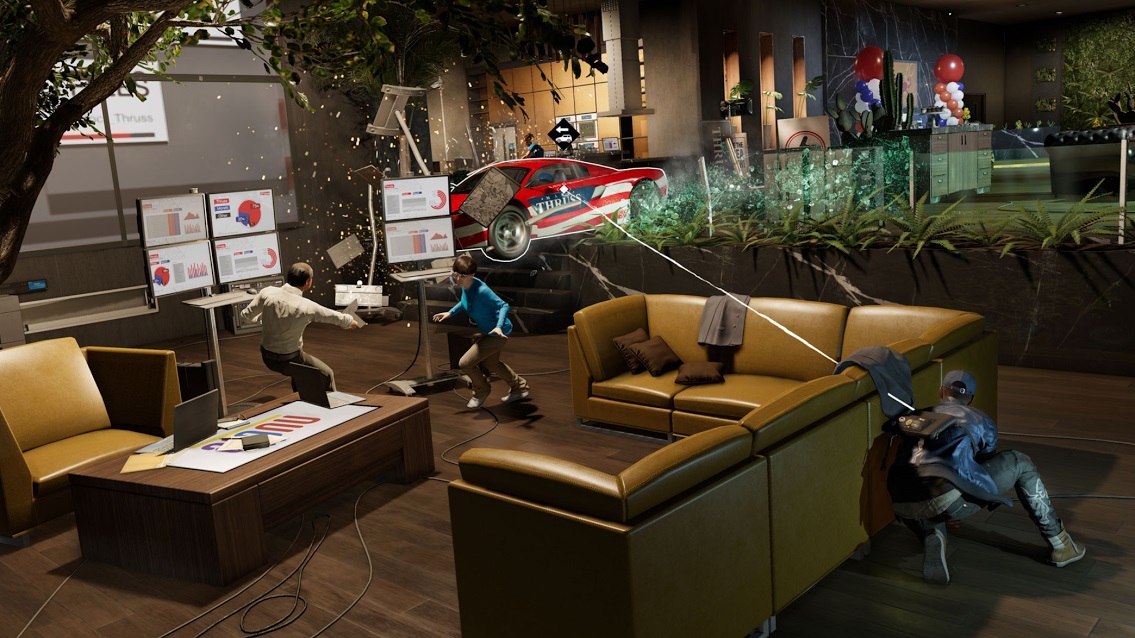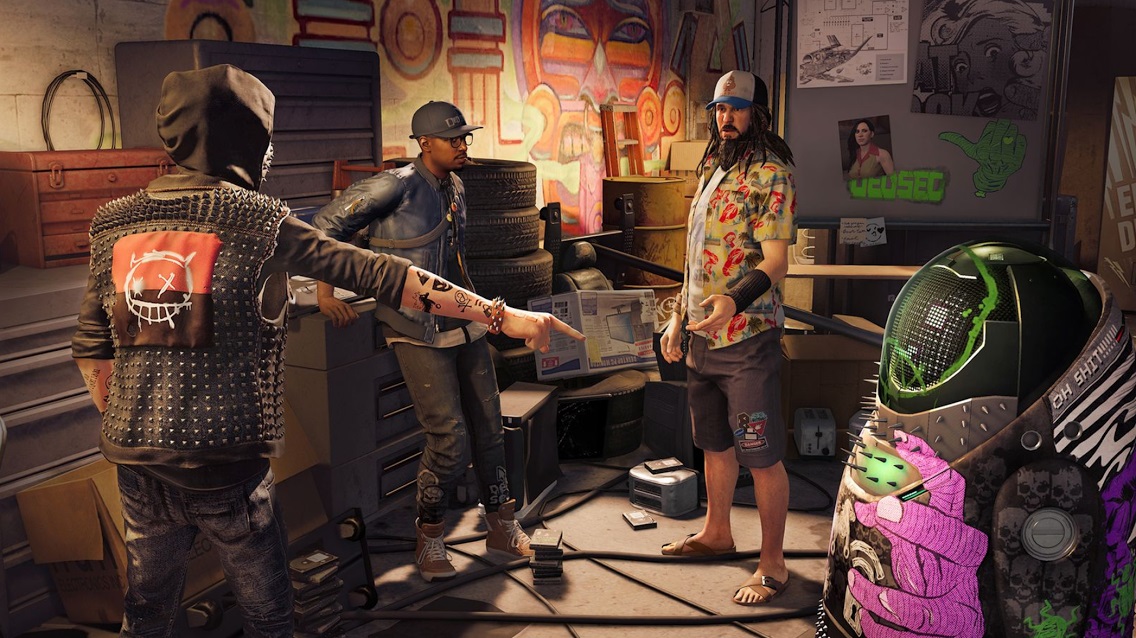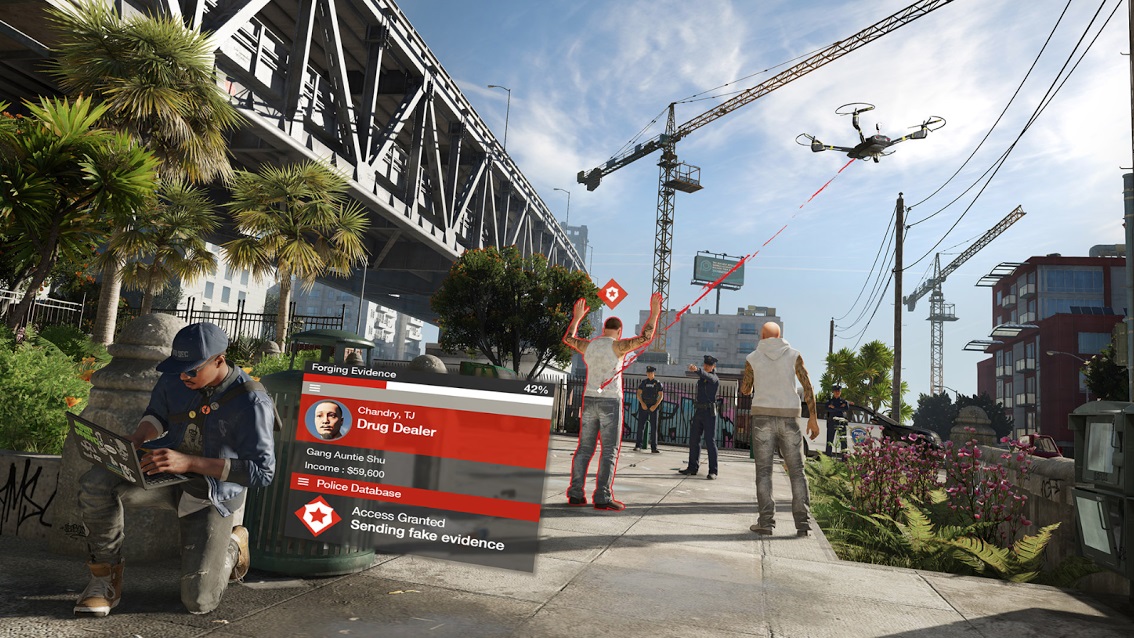Editor’s note: This review previously appeared on Feminist Frequency and is reprinted here with permission.
In our hyperconnected world, where most of us carry around handheld devices that keep us linked to the internet at all times and tech companies monitor our behavior and purchasing habits constantly, a game in which you harness that technological web to disrupt the schemes of powerful corporations makes perfect sense. But with 2014’s Watch Dogs, Ubisoft failed to turn this premise into a compelling game. Watch Dogs 2 makes some meaningful improvements on its predecessor: it gives us a more memorable hero and supporting cast, and a San Francisco that exudes a bit more personality than the first game’s setting did. Unfortunately, Watch Dogs 2 still fails where it matters most, trotting out a series of crushingly repetitive missions that never comes close to making you feel like a hacker extraordinaire.
Nearly every main story mission has you infiltrating some heavily guarded facility or another in order to steal something or hack something, and once you find a strategy that works for you, it’s very easy to fall into a pattern of approaching all of these missions in more or less the same way. Your character, Marcus Holloway, can’t take much punishment, and the environments are filled with enemies who will immediately call for more reinforcements at any sign of trouble, so you’re discouraged from relying on the all-out, guns-blazing approach.

This makes sense in a game that wants you to use your hacker abilities to tackle the situations you’re faced with, but because failure in this game can be so punishing and send you back so far, I tended to complete most missions using the same tactic. The core of my strategy was hanging back, hacking into the building’s security systems, and picking off the enemies who could call for reinforcements one by one by forging criminal records and having the police come in and arrest or kill them. It was passive and often tedious, but it got the job done.
Of course, sometimes it’s a strength when a game punishes you for failure. In games with precise combat, the prospect of a significant setback can raise the stakes, encouraging you to master the mechanics and making your victories all the more rewarding. But Watch Dogs 2 is no such game. This is no Dark Souls. This is a by-the-numbers open-world game with mediocre gunplay and systems that interact so erratically that all you can do is try to manage them well enough to complete your objective and get out alive.
As shabby as the mission design is, the game deserves some credit for its obviously well-intentioned efforts to acknowledge the existence of structural racism. At one point, the young black protagonist Marcus discusses the racial profiling tactics that tagged him as a criminal risk, and his brother-in-arms Horatio, whose day job is at the Google stand-in Nudle, comments frankly on the racism and condescension he experiences as one of the only people of color in an overwhelmingly white company. The presence of Miranda, a black trans councilwoman who does what she can to help Marcus and his colleagues in the hacker collective known as DedSec, is also welcome. On the other hand, Latinx people in Watch Dogs 2 are primarily represented as the most cliche kinds of gang members imaginable.

As important as it is that games give us heroes and supporting characters who break from the long-established molds, there’s more to great characterization than simply ticking off a few boxes on a diversity checklist, and Watch Dogs 2 falls short here. Its characters relate to each other more in geek sci-fi references and cheesy one-liners than in anything that actually reveals to us who they are and what makes them tick, so it’s hard to get invested in their struggle and their relationships with each other.
Watch Dogs 2’s San Francisco setting is recognizable but doesn’t feel authentic, despite being packed with landmarks and familiar locations, including San Francisco’s greatest treasure: the sea lions down at pier 39. It’s great to see Pride flags flying in certain spots around the city, and Watch Dogs 2 makes no effort to minimize or deny the existence of SF’s queer community. But for all that, the game’s concerns feel oddly detached from the real issues that face San Francisco today. Graffiti that reads “Artists used to live here” poignantly speaks to the fact that entire communities are being driven out of the city as tech companies make life here unsustainable for so many, and the occasional passerby may make mention of the gentrification that’s taking place. So why isn’t DedSec using its power to stand up for marginalized communities? Why isn’t DedSec fighting for affordable housing, and fighting against the police injustice that specifically targets people of color? Why not confront the things that are really happening here, the things that really matter to the people who call San Francisco home?

Perhaps the strangest thing of all about Watch Dogs 2, though, is its uneasy relationship with power. Ostensibly DedSec is all about waking up the populace, getting them to understand how power is abused by politicians, tech companies, and government agencies to limit people’s freedom to think and act for themselves. But what DedSec never does is turn that questioning lens on its own use and abuse of power. It was never lost on me that, playing as a young black man who had been profiled as a likely criminal because of his race, I then harnessed the power of technology to forge criminal records for dozens and dozens of innocent people and watched them get marched off by the cops themselves. But hey, what was I gonna do? I had a mission to complete.
Carolyn Petit is a longtime professional game critic and currently the managing editor of Feminist Frequency.
—The Mary Sue has a strict comment policy that forbids, but is not limited to, personal insults toward anyone, hate speech, and trolling.—
Follow The Mary Sue on Twitter, Facebook, Tumblr, Pinterest, & Google+.









Published: Nov 16, 2016 04:17 pm